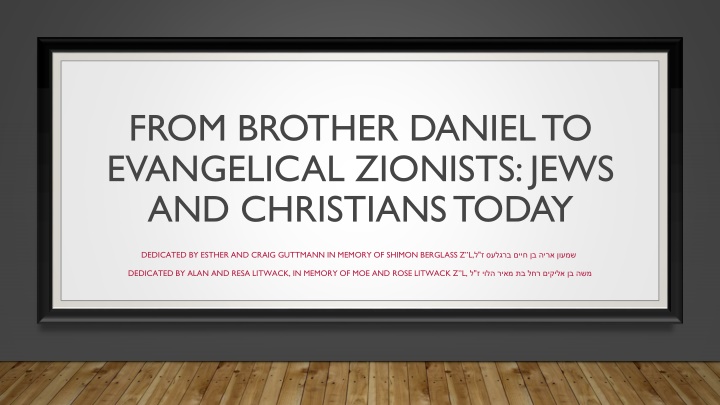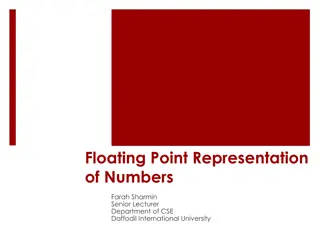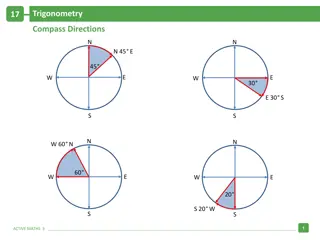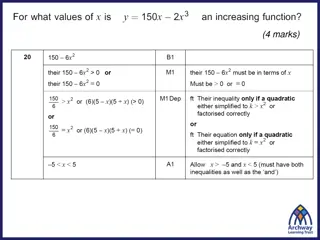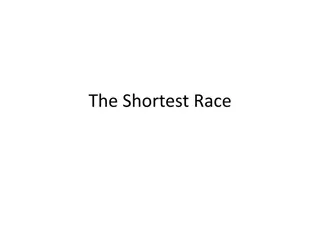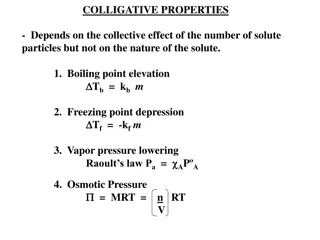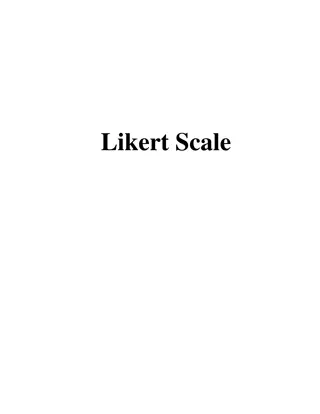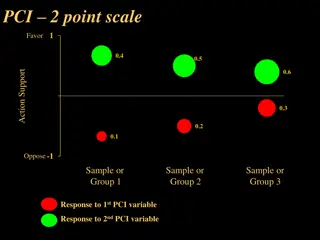The Remarkable Story of Brother Daniel: A Journey of Faith and Courage
Brother Daniel, originally known as Oswald Rufeisen, was born Jewish in Poland. Fleeing the Nazis, he saved many lives during the Holocaust by risking his own. His unique path led him to find shelter in a convent where he eventually converted to Christianity, finding solace in the New Testament. Despite challenges, his actions exemplified bravery and compassion.
Uploaded on Dec 07, 2024 | 0 Views
Download Presentation

Please find below an Image/Link to download the presentation.
The content on the website is provided AS IS for your information and personal use only. It may not be sold, licensed, or shared on other websites without obtaining consent from the author.If you encounter any issues during the download, it is possible that the publisher has removed the file from their server.
You are allowed to download the files provided on this website for personal or commercial use, subject to the condition that they are used lawfully. All files are the property of their respective owners.
The content on the website is provided AS IS for your information and personal use only. It may not be sold, licensed, or shared on other websites without obtaining consent from the author.
E N D
Presentation Transcript
FROM BROTHER DANIEL TO EVANGELICAL ZIONISTS: JEWS AND CHRISTIANS TODAY DEDICATED BY ESTHER AND CRAIG GUTTMANN IN MEMORY OF SHIMON BERGLASS Z L, " DEDICATED BY ALAN AND RESA LITWACK, IN MEMORY OF MOE AND ROSE LITWACK Z L, "
THE CASE OF BROTHER DANIEL Image from wikmedia
WHO WAS BROTHER DANIEL? Originally known as Oswald Rufeisen, he was born Jewish in Zadziele, a village in the south of what is now Poland in 1922 Because his had fought for the Germans in World War I, and the high status that the German language carried in Poland at the, German was Rufeisen's primary language at home. Unusually for Jews of limited means, Rufeisen finished school in 1939 and was awarded his matura.' His education and his fluency in German would both prove invaluable Aaron R. Petty, The Concept of "Religion" in the Supreme Court of Israel, 26 Yale J.L. & Human. (2014). Available at: https://digitalcommons.law.yale.edu/yjlh/vol26/iss2/2 The Concept of "Religion" in the Supreme Court of Israel
WHO WAS BROTHER DANIEL? When the Germans invaded Poland , Rufeisen fled with his brother. He first fled to Lviv, Ukraine and then to Vilna. After Vilna, was taken by the Germans, Rufeisen was detained. However, because he know the shoemaking trade he was hired by the Nazis work with the leather they had confiscated. After the leather ran out, he fled to the farm of a man whom he met in the street and then Belarus to the man s brother. In Belarus, disguised as a gentile, he used his knowledge of German to work as a translator for the police
WHO WAS BROTHER DANIEL? Oswald, had special access to classified information which he would leak to Jews he met in the area. When he learned that the Mir ghetto would be liquidated, he sent the police to chase partisans who didn t exist to buy his friends time to escape. He also provided them with weaponry. Rufeisen was found out, admitted he was a Jew and fled.
BROTHER DANIEL: THE CONVERSION Rufeisien found shelter in a convent, where he read the New Testament and various Carmelite publications. Less than three weeks later, Rufeisen asked the mother superior to baptize him. He felt that it was not a rejection of his Jewish heritage; he wanted a stronger connection to the New Testament, which he read as a Jewish document. In particular, the account of the death and resurrection of Jesus helped him to cope with the horrors of the Holocaust. When he felt he was endangering the nuns, he fled from the convent and joined a group of partisans. They suspected him of being a German and would have killed him but one of the Jews he saved from the Mir ghetto recognized him.
BROTHER DANIEL: THE LAW OF RETURN After the war, Rufeisen joined a Carmelite Monastery in Czerna. He knew they had a division in Israel and wanted to make Aliyah. He took as final vows as a monk in 1949 and then become Brother Daniel. When he was given permission to relocate to Israel, he was told because of his conversion he could not emigrate as a Jew and instead received a one year visa. Rufeisen ultimately sued the Minister of the Interior, claiming the he was born a Jew, and therefore still a Jew.
BROTHER DANIEL: THE SUPREME COURT "Appearing before the Supreme Court in brown habit and sandals," Rufeisen spoke of "the sufferings and ordeals he endured as a Jew and the pride he felt in being Jewish and in the State of Israel. However, the court came to a unanimous decision that Brother Daniel should not be granted citizenship under the law of Return. Rufeisen appealed the decision in 1962 and was rejected again. Rufeisen lived the rest of his life in the Carmelite monastery and ultimately became a naturalized citizen.
ONCE A JEW ALWAYS A JEW? A HALACHIC PERSPECTIVE Is an apostate still a Jew? The answer is complicated: There various types of apostates and various halachic questions which are contingent upon Jewish Status.
ONCE A JEW ALWAYS A JEW? A HALACHIC PERSPECTIVE In his article on the topic (Leaves of Faith, Chapter 3- Brother Daniel and the Jewish Fraternity ) , Rabbi Aharon Lichtenstein listed: Types of apostates : 1. - An apostate who sins wilfully to satisfy an urge. 2. - An apostate who sins out of rebellious spite 3. - An apostate who desecrates Shabbat publicly. 4. - A polyetheistic believer and worshipper. 5. - One who abandons Judaism entirely
ONCE A JEW ALWAYS A JEW? A HALACHIC PERSPECTIVE Areas of Halacha contingent Upon Jewishness Reliance for Mitzvah Performance- Can we eat from their Shechitah, or use a Sefer Torah they write? Interpersonal Obligations Related to Brotherhood - Charging Interest, Returning a Lost Object etc. Questions of Intrinsic Personal Status- Marragie, Yibum etc.
ONCE A JEW ALWAYS A JEW? A HALACHIC PERSPECTIVE- Talmud, Yibamot 47a (William Davidson Edition) : Once he has immersed and emerged he is a Jew in every sense. The Gemara asks: With regard to what halakha is this said? It is that if he reverts back to behaving as a gentile, he nevertheless remains Jewish, and so if he betroths a Jewish woman, although he is considered to be an apostate Jew, his betrothal is a valid betrothal. : Tamud, Sanhedrin 44a " ) , ( Israel has sinned (Joshua 7:11), Rabbi Abba son of Zavda said: Even though (a Jew) has sinned they are still [considered] a Jew Conclusion- Once A Jew, always a Jew
ONCE A JEW ALWAYS A JEW? A HALACHIC PERSPECTIVE Talmud, Yibamot 17a (William Davidson Edition) . , - : " Rav Yehuda said that Rav Asi said: With regard to a gentile who betrothed a Jewish woman nowadays, we are concerned that the betrothal might be valid, despite the fact that a betrothal of a gentile is meaningless, lest he be from the ten tribes of Israel who intermingled with the gentiles. ' , ) ( " There are those who say that Rav Yehuda actually related the following: When I said this halakha before Shmuel, he said to me: They did not move from there, the place where they deliberated on this matter, until they rendered all of them, including those who intermingled with the ten tribes in different locations, full-fledged gentiles. Consequently, there is no concern that their betrothals might be of any effect, as it is stated: They have dealt treacherously against the Lord, for they have begotten strange children (Hosea 5:7). This Source indicates that one can lose their Jewishness!
WHO IS A JEW IN HALACHA?- SOLVING THE CONTRADICTION There seems to be a contradiction between these two sources. Does halacha recognize the marriage of an apostate to another Jew or not? Approach 1-> The 10 lost tribes were an exception but fundamentally: Once a Jew always a Jew . Rabbi Menachem ben Meir (14th century Provence) - They had a tradition that all descendants of the 10 lost tribes had ultimately intermarried and assimilated. Rabbi Shlomo ibn Aderet (13th century spain)- The Rabbis revoked their marriages.
WHO IS A JEW IN HALACHA?- SOLVING THE CONTRADICTION Approach 2- However there are rabbinic sources which indicate more generally that when totally distanced from the Jewish People, one can fundamentally lose their Jewishness: Meiri on Yibamot 22a: Chalitzah for an Apostate Some Geonim have suggested a novel idea that if when the husband married her, his brother was an apostate she doesn t require chalitzah (shoe removal) from him. Similarly, if the husband was an apostate and she remained with him, and he died in his apostasy without children she doesn t require Yibum (levirate marriage ) for this isn t his brother .
THE CHIDUSH OF RABBI CHAIM SOLEVEICHIK
THE CHIDUSH OF RABBI CHAIM SOLEVEICHIK Rabbi Joseph B. Soleviechik (20th century America), Reshimot Shiurim on Yibamot 17a Our Master, the Geon R Chaim suggested that the Rambam held the Sages made the 10 tribes into full- fledged gentiles and uprooted from them all legal effects of Jewish sancity " " " " ... R Chaim added that the Rambam implies that the fundamental concept is that if there is a group of Jews who are apostates for the whole of Torah, and the title of Jew has sunk from them, and even the gentiles around them don t consider them Jews but gentiles, then the Sages have biblical power to remove the legal effects of their Jewish sanctity from them and to make them gentiles for all laws, even for leniency , " " , " " " .
THE CHIDUSH OF RABBI CHAIM SOLEVEICHIK R Chaim added that it s logical that the court doesn t need to sit to uproot the Jewish sanctity from these groups. Rather they are simply clarifying the matter. For their Jewish sanctity is uprooted naturally. " " , " " . , , " " " " , , - " " Therefore, R Chaim suggested regarding the status today of the descendants of the Jews who remained in Spain after the inquisition known as the "Moranos", from whom for generations the title of Jews has been lost, and they today identify themselves as Gentiles from the Spanish people, as do the gentiles around them, since they have assimilated so heavily, their Jewish sanctity has naturally been uprooted and they are gentiles by law for all rules, whether for leniency, stringency, biblical, or rabbinice. It is an incredible innovation! " , ,
RABBI AHARON LICHTENSTEIN: BROTHER DANIEL AND THE JEWISH FRATERNITY
RABBI AHARON LICHTENSTEIN: EXPLAINING R CHAIM 2 Types of Apostates 1) An apostasy of Action- A sinner 2) An Apostasy of Person- Someone who no longer identifies as Jewish Such persons are not simply disqualified because of some apostate act. Nor are they merely treated as if they were foreign. They are people who have betrayed G-d for they have begotten foreign children .
RABBI AHARON LICHTENSTEIN: EXPLAINING R CHAIM Qualifier: Nevertheless, Rav Lichtenstein argued that even a full- fledged apostate retains the epithet of Jew . In certain respect, he is a Jew without Jewishness . Apostates also have the theoretical obligation to observe the mitzvot If they decide to return, they may not need to go through a conversion
CHRISTIANITY- A BREAK FROM JUDAISM Rabbi Lichtenstein argues that in a sense, Brother Daniel was a more extreme apostate than the pagan idolater of old. The paganistic cults of the Middle-East weren t considered to be mutually exclusive. Christianity however is seen as a break from Judaism. Furthermore, not all apostates are the same. There is a difference between as a person who identifies as a Christian to get into university and a person is ordained as a monk.
IS THERE A DUALITY BETWEEN JEWISH NATIONHOOD AND THE JEWISH RELIGION? Rabbi Lichtenstein argues that a complete apostate can t truly call themselves a member of the Jewish nation. Being Jewish means identifying with the spiritual Jewish cause, and the historical Jewish destiny. Therefore, we ask the convert, if he knows that the Jewish people, are persecuted, oppressed, despised, harassed, and overcome by afflictions (Talmud, Yibamot 47a). A convert must identify with the Jewish Destiny.
JEWISH IDENTITY REQUIRES BOUNDARIES The underlying theory behind the exclusion of Brother Daniel , is that the faith community of Judaism has boundaries. When a person leaves those boundaries, they can no longer be considered part of the community. The obvious conclusion is that we as Jews shouldn t see ourselves as members of the same faith community as Christians. The question arises: how should we look at friendly Christian neighbours who share biblical values, and a contribute to the state of Israel and other Jewish causes. Can we unite on a religious level?
CONFRONTATION In 1964, at the Midwestern Conference of the Rabbinical Council of America, Rabbi Joseph B. Soleveichik wrote a landmark paper on the topic of Jewish-Christian Dialogue Rabbi Soloveichik begins by defining three spheres of human identity.
CONFRONTATION- THREE PERSPECTIVES ON OTHERNESS 1. Simple Natural Being- typified by man in Genesis 2:5-7- Man who was created out of the dust of the ground, enveloped in a mist rising from the jungle, determined by biological immediacy and mechanical necessity, knows of no responsibility, no opposition, no fear, and no dichotomy, and hence he is free from carrying the load of humanity . 2. Man as Subject sees the World as an object- We realize the we are different and see the world as an outsider. At this point (Genesis 2:15), we are given divine mandates to work and keep the land. 3. Man gazes at another Human- the interaction of Subject to Subject- Adam unites with Even (Genesis 2:18-22)
CONFRONTATION FROM TRADITION: A JOURNAL OF ORTHODOX THOUGHT, 1964 VOLUME 6, #2 RABBI JOSEPH B. SOLOVEICHIK We Jews have been burdened with a twofold task: we have to cope with the problem of a double confrontation. We think of ourselves as human beings, sharing the destiny of Adam in his general encounter with nature, and as members of a covenantal community which has preserved its identity under most unfavorable conditions, confronted by another faith community. We believe we are the bearers of a double charismatic load, that of the dignity of man, and that of the sanctity of the covenantal community. In this difficult role, we are summoned by God, who revealed himself at both the level of universal creation and that of the private covenant, to undertake a double mission - the universal human and the exclusive covenantal confrontation.
THREE IMPORTANT DISPARITIES 1. Divine Imperatives- We don t have the same mitzvot. 1. Even the mitzvot we (share) aren t the same 2. Dogma- We don t have the same conception of Monotheism and we are both convinced that ours is true. 3. Eschatology- We both believe that at the end of time all people will see truth of our religions
RABBI SOLEVEITCHIK ON JUDEO-CHRISTIAN TRADITION Viewing the relationship between Judaism and Christianity under this aspect, it is quite legitimate to speak of a cultural Judeo-Christian tradition for two reasons: First, Judaism as a culture has influenced, indeed, molded the ethico-philosophical Christian world-formula. The basic categories and premises of the latter were evolved in the cultural Judaic orbit. Second, our Western civilization has absorbed both Judaic and Christian elements. As a matter of fact, our Western heritage was shaped by a combination of three factors, the classical, Judaic, and Christian, and we could readily speak of a Judeo-Hellenistic- Christian tradition within the framework of our Western civilization. However when we shift the focus from the dimension of culture to that of faith - where total unconditional commitment and involvement are necessary - the whole idea of a tradition of faiths and the continuum of revealed doctrines which are by their very nature incommensurate and related to different frames of reference is utterly absurd, unless one is ready to acquiesce in the Christian theological claim that Christianity has superseded Judaism.
FOUR PRECONDITIONS FOR INTERFAITH DIALOGUE 1. Neither community, the few (i.e the Jewish Community) nor the many (i.e the Christian Community) can pressure the other community to deny its validity. 2. Faith is singular, and personal. We shouldn t make the mistake of viewing the other, or letting them view us as objects rather than subjects. Therefore, debate shouldn t revolve around matters of faith. 3. Third, we members of the few should refrain from asking the many to emend their texts (i:e abandon replacement theology etc.) 4. Fourth, we members of the few shouldn t intimate a willingness to trade favors .
STATEMENT ADOPTED BY THE RABBINICAL COUNCIL OF AMERICA AT THE MID-WINTER CONFERENCE, FEBRUARY 3-5, 1964 We are pleased to note that in recent years there has evolved in our country as well as throughout the world a desire to seek better understanding and a mutual respect among the world's major faiths. The current threat of secularism and materialism and the modern atheistic negation of religion and religious values makes even more imperative a harmonious relationship among the faiths. This relationship, however, can only be of value if it will not be in conflict with the uniqueness of each religious community, since each religious community is an individual entity which cannot be merged or equated with a community which is committed to a different faith. Each religious community is endowed with intrinsic dignity and metaphysical worth. Its historical experience, its present dynamics, its hopes and aspirations for the future can only be interpreted in terms of full spiritual independence of and freedom from any relatedness to another faith community.
STATEMENT ADOPTED BY THE RABBINICAL COUNCIL OF AMERICA AT THE MID-WINTER CONFERENCE, FEBRUARY 3-5, 1964 Any suggestion that the historical and meta-historical worth of a faith community be viewed against the backdrop of another faith, and the mere hint that a revision of basic historic attitudes is anticipated, are incongruous with the fundamentals of religious liberty and freedom of conscience and can only breed discord and suspicion. Such an approach is unacceptable to any self-respecting faith community that is proud of its past, vibrant and active in the present and determined to live on in the future and to continue serving God in its own individual way. Only full appreciation on the part of all of the singular role, inherent worth and basic prerogatives of each religious community will help promote the spirit of cooperation among faiths. It is the prayerful hope of the Rabbinical Council of America that all inter-religious discussion and activity will be confined to these dimensions and will be guided by the prophet, Micah (4:5) "Let all the people walk, each one in the name of his god, and we shall walk in the name of our Lord, our God, forever and ever."
RECENT DEVELOPMENTS Nostra Aetate- 1) The church no longer blames all Jews for the crucifixion 2) Anti-Semitism can t be tolerated Since the spiritual patrimony common to Christians and Jews is of such magnitude, this Sacred Synod wants to foster and recommend that mutual knowledge and respect that are, above all, the fruit of biblical and theological studies as well as of fraternal dialogues. Moreover, this Synod, in her rejection of injustices of whatever kind and wherever inflicted upon people, and recalling our common patrimony, deplores and condemns hatred and persecutions of Jews, whether they arose in former or in our own days.
CRITICISMS OF RABBI SOLEVITCHIKS APPROACH TODAY 1. Historical Development- The Church is no longer trying to missionize Jews. The primary concern was disputation not dialogue 2. Commonality- We do share biblical values with Christians. 3. Universalism- We have a responsibility to unite to Call out in the Name of G-d 4. Promoting Theism
RABBI DAVID ROSEN Orthodox Judaism and Jewish-Christian Dialogue If Christianity is acknowledged to espouse beliefs and values that the Jewish people believe to be amongst those fundamental teachings that it brought to the world and for which it was elected; and as Judaism aspires for their recognition and fulfillment in the whole world; then their desecration, especially by those claiming to represent these beliefs and values among the Gentiles, must be our Jewish concern.
TWO MODERN SCHOOLS OF THOUGHT 1. Segregationists- Jews and Christians should respect the differences between our faith communities and work together on cultural issues 1. Rabbi Dr. David Berger, Rabbi Meir Soloveichik 2. Assimilationists- Although Judaism and Christianity certainly differ, we can value the religious contributions of each and have a healthy dialogue 1. Rabbi Eugene Korn, Rabbi David Rosen, Dr. David Novak
RABBI NACHUM RABINOVITCH, ACCEPTING DONATIONS FROM THE INTERNATIONAL FELLOWSHIP OF CHRISTIANS AND JEWS ' , . " . " Our generation has been blessed with a unique blessing many generations have yearned for: to see the actualization of the G-d s promise of Israel s return to its land. This opportunity gives us the responsibility to meet the challenge of fulfilling the historical destiny of the nation of Israel: and you shall be for me a kingdom of priests and a holy nation . In every era, new thinking is required to determine how to actualize this historical destiny.
THE WORDS OF THE RAMBAM Rambam, Laws of Kings 11:6 (Reuven Brauner) " , ' . , " , , , , ) . , , ( , , Even Jesus the Nazarene who imagined he would be the Messiah and was killed by the Court. was prophesized about by Daniel as it says, and also the children of the violent among your people will lift themselves up to establish the vision, but they shall stumble (Daniel 11:14). Was there ever a greater impediment than this one? All the Prophets spoke of the Messiah, Redeemer of Israel and Savior and Gatherer of the Exiles and Strengthener of the Commandments. But this one caused the ruin of Israel by the sword and the dispersal of its remnant and its humiliation and reversed the Torah, and caused most of the world to err and worship a god other than HaShem (G-d).
THE WORDS OF THE RAMBAM ' ) . . , " ( ' , , , " : , Nonetheless, the Thoughts of the Creator of the World are beyond any man s understanding. For our ways are not His Ways, and our thoughts are not His Thoughts. And all the doings of Jesus the Nazarene and that of that Ishmaelite. who came after him are nothing but to pave the way for the King Messiah and prepare the entire world to worship G-d together, as it says, For thenWhen they will realize that their Messiahs were false will they abandon them and turn to G-d s true Messiah. I will turn to the peoples a pure language, that they may all call upon the Name of the Lord, to serve Him with one consent (Zephania 3:9).
REVIEW QUESTIONS Q1- Can A Jew Lose Their Jewishness> Q2- Can one be a member of both the Jewish Nation and the Christian Nation? Q3- Should we see ourselves as part of a greater Judeo Christian community? Q4- Under what circumstances is inter-faith dialogue appropriate? Q5- How should we approach today s paleo-semetic, Zionist Christian?
